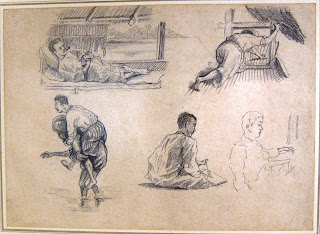MAPPING (I): TANAH MELAYU @ NVAG
Now that the ground floor galleries are fit for public display, “MAPPING” promises to be the most exciting initiative undertaken by the art institution in recent times. If all goes well, this progressively amalgamating two-year project will form the basis for a permanent exhibition of the national collection, a maiden achievement for the Balai Seni Lukis Negara. At Galeri Reka, “TANAH MELAYU: Pembentukan Dari Kolonisasi” offers an arbitrary start to local art history, with drawings and watercolours made in the 1880s by British colonial officers. Exploring village settlements via boat, explorers such as Frank Swettenham and George Giles successfully capture a historical landscape, during their terrain mapping efforts.
 |
| William Samwell – Dyak Campong Kapan Landak River (1890) |
Timelines and wall texts make the walkthrough an enjoyable one, as careful illustrations of figures and cross-hatched landscapes, are paired with humorous vignettes about inside jokes and local encounters. While drawing and painting are recognised as a Western practice, this show does not fully justify how its exhibits fit into Malaysia’s visual art history. Pictorial records of Tanah Melayu by European travellers and Chinese traders are decades older; Closer to home, Ahmad Suhaimi proposes in Sejarah Kesedaran Visual di Malaya, that Malay writer Munshi Abdullah (d. 1854) “…had a huge talent in visual art (…) His ‘strokes indicate that Abdullah was a serious artist.” Nevertheless, the presented starting point is sufficiently credible, for the viewer to proceed to the next exhibition segment…
 |
| George Giles – Boat Life on the Pahang River (1885) |
“He had a large book made of thick paper, and he used to put in it all kinds of leaves and flowers, etc. And if there was anything which he could not put in it, he had a Chinaman, a Cantonese, who was very clever at drawing pictures of either fruits or flowers, which he painted like life, and he told him to paint all these things. Besides all this, he had a barrel which was full of either arrack or brandy, I don’t know which, into which he put such creatures as snakes and centipedes and scorpions ; he put them in alive, and after two days he took them out, and put them in bottles, where they looked as if they were alive. The people of Malacca were astonished to see all this.”
– Hikayat Abdullah, Abdullah bin Abdul Kadir (1849) [translated by W.G. Shellabear. 1918]
 |
| Frank Swettenham – A Malay Mosque from A Malay Window, Ulu Bernam (1884) |
Comments
Post a Comment